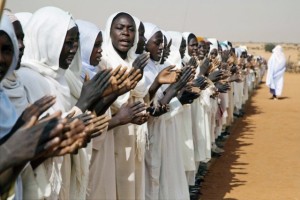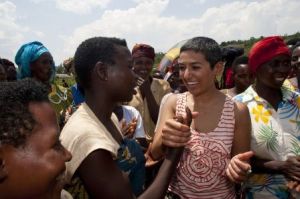Brazil – it’s a country known for its soccer fanatics, booming economy, and of course, its beautiful women. Last year, I spent two weeks exploring the barrios of Rio de Janeiro, drinking potent caipirinhas, and absorbing a cancerous amount of rays on the beaches of Buzios.
 I’m embarrassed to admit that before my trip I built up a Hollywood image of the culture. I envisioned the country as an incessant party with scantily clad, Carmen Miranda-like women dancing in the streets.
I’m embarrassed to admit that before my trip I built up a Hollywood image of the culture. I envisioned the country as an incessant party with scantily clad, Carmen Miranda-like women dancing in the streets.
Apparently, the idea that Brazil is full of topless women hanging out on the beaches is common among tourists – perhaps a contributing factor to speculation that Brazil has surpassed Thailand as the world’s top sex tourism destination.
I’m not sure how I conjured up such an unrealistic impression of the country. I’ve spent significant time living and traveling all over Latin America. I shouldn’t have been surprised when I noticed similar social disparities in Brazil.
Brazilian culture varies drastically by regional, ethnic, and tribal influences. Rio is severed by a dramatic poverty line which is especially apparent in the city’s infamous favelas. And the interactions of Brazilian men and women reveal hints of machismo attitudes.
Brazil stands out among the Latin American countries from a fiscal standpoint. The country boasts one of the world’s fastest growing economies, and its powerhouse size alludes to large amounts of untapped resources available for profitable development.
Recent events point toward changing dynamics. Brazil elected its first female president, Dilma Rousseff, in January 2011. It was also chosen as host for the World Cup in 2014 and the Olympic Games in 2016, two events that will foster substantial increases in development and tourism.
So why had I focused solely on the appearance of the country’s female population?
According to native Brazilian, Alex Goncalves de Oliveira, local women are plagued by a stereotype that precedes them. Alex grew up in Tres Coracoes, a smaller city in the southeastern province of  Minas Gerais. She says, “Most people think of Brazilian women as sex symbols, amounting to nothing more than itty-bitty-bikini-wearing, samba-dancing girls. But the ultimate irony is Brazil’s first female President is a strong leader, who’s a little plump, sports a boyish haircut, and has a deep, raspy voice.”
Minas Gerais. She says, “Most people think of Brazilian women as sex symbols, amounting to nothing more than itty-bitty-bikini-wearing, samba-dancing girls. But the ultimate irony is Brazil’s first female President is a strong leader, who’s a little plump, sports a boyish haircut, and has a deep, raspy voice.”
Alex believes the stereotype is perpetuated by the media and by the relationships between Brazilian men and women. Although she’s noticed improvement in recent years, Alex tells me about the ‘womanizing’ tendencies of Brazilian men. Cheating, spousal abuse, and alcoholism are common and somewhat socially acceptable. As in most societies, the reputations of women are easily bruised. The women have a lot more to overcome to get ahead.
Nicole Scholet, an American friend of mine, agrees Brazilian women suffer unjust labels, but admits the culture places an extreme focus on physical appearance. She spent two months living in Brazil when Lula was President and six months a year later under Rousseff.
 Nicole says, “Brazil is such a place of paradoxes. Brazilian women care a lot about their appearance. They always wear makeup and do their hair. They never look scrubby – even if they’re walking to the corner store to buy bread. While I was living there, several people told me I would look better if I wore makeup more often.”
Nicole says, “Brazil is such a place of paradoxes. Brazilian women care a lot about their appearance. They always wear makeup and do their hair. They never look scrubby – even if they’re walking to the corner store to buy bread. While I was living there, several people told me I would look better if I wore makeup more often.”
Nicole confesses, “Brazilians aren’t as judgmental about body types as Americans. Every woman (regardless of weight) wears a thong bikini, and it’s not considered scandalous or sexual. You never hear ‘She’s too fat for that swimsuit.’ In the States we make critical remarks about people, but in Brazil the focus on the female body tends to be in an appreciative way. As a woman, I felt way more attractive [in Brazil] than in the US.”
This focus on outward appearance contributes to foreign stereotypes, but may not be to the total detriment of Brazilian women. At least from an education perspective, Brazilian women don’t seem hindered by elements of machismoism in their society.
 In Brazilian schools, females represent a majority at every grade level. Alex tells me, “Almost all the women in my family attended high school and went on to graduate college. My grandmother was widowed in her late 20’s and left with five mouths to feed. She became a school teacher and eventually the director of the school in her town. All of my female cousins graduated from university and some are working toward their Masters. Last year, one of my aunts got her PhD, and won Brazil’s top award for research in Journalism. Sadly, the men in our family have stayed behind. I can’t think of one who has graduated college.”
In Brazilian schools, females represent a majority at every grade level. Alex tells me, “Almost all the women in my family attended high school and went on to graduate college. My grandmother was widowed in her late 20’s and left with five mouths to feed. She became a school teacher and eventually the director of the school in her town. All of my female cousins graduated from university and some are working toward their Masters. Last year, one of my aunts got her PhD, and won Brazil’s top award for research in Journalism. Sadly, the men in our family have stayed behind. I can’t think of one who has graduated college.”
It will be interesting to watch the country’s progress over the next decade. The emphasis placed on the education of its female population will certainly help Brazil stay in the forefront of the emerging economies.
If Rousseff’s election as President is any indication, Brazil’s future political and business sectors will be filled with a powerful set of female leaders. I don’t predict their itty-bitty-bikinis going out of style anytime soon, but these women should be able to rid the nation of any stereotypes that don’t serve them well.











